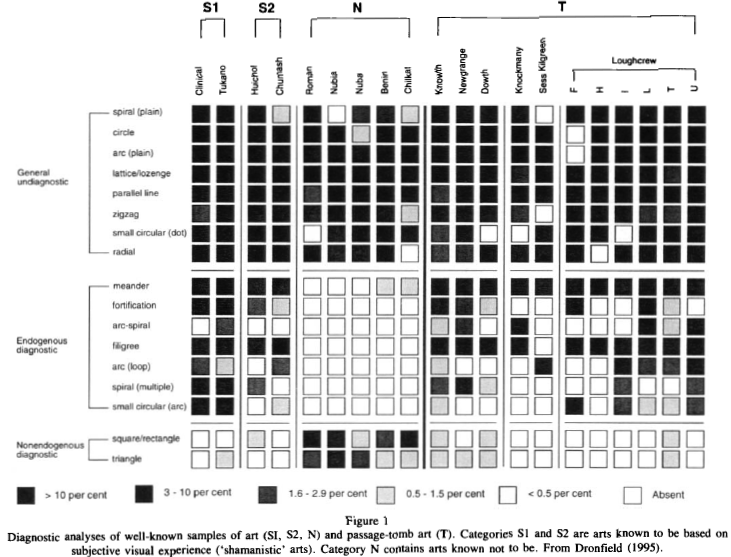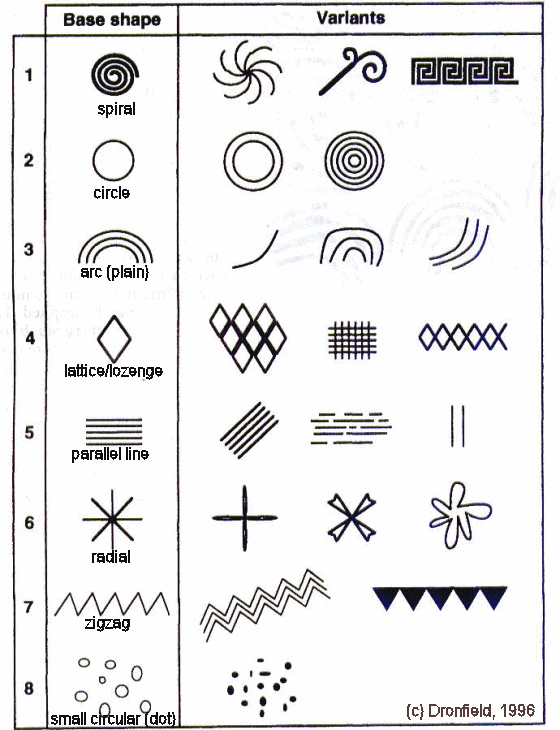From the first table it looks that
the distinction between the distribution of
type of shapes is able to
indicate the
type of art.
Evaluation
Remarks 1
My remarks on Dronfield's methodology [
1996]:
- There is a certain amount of circularity in his argument;
the distinction between diagnostic and undiagnostic (type of shapes) is
determined by the same set of types of art. Don't know how serious the
consequences are.
- The endogenous diagnostic shapes were
caused/defined by sensory (electrical stimulation, deep
pressure and flickering lights) and intraneural (hallucinogenic substances,
pathological syndromes) stimulation. A large scope of
causes!
- Chi-Square method
is used to determine the significance. He used the
percentages of occurrences in the Chi-Square method, which
is not correct (as he say himself). The significance is also
not very high (~88%). But it still might be ok-ish.
- One can use Chi-square for many
types
of distributions, so perhaps also ok for the
distribution of type of
shapes?
- Because of the large scope of the above definition of
endogenous diagnostic shapes, it is not possible to proof
that endogenous diagnostic shapes are due to hallucinogenic
substances only.
Remarks 2
My remarks on Dronfield [
1995]:
- Looking at the Irish Megalithic art (see the Type of art table) there looks to a
similarity with the S1 and S2 type of art.
- In this study Dronfield [1995],
uses
results from:
- Sensory stimulation (electrical stimulation; no deep
pressure or light flickering were included)
- Intraneural stimulation (hallucinogenic substances; no
pathological syndromes were included )
- Remember, I don't relate endogenous diagnostic shapes strongly to
only intraneural stimulation (hallucinogenic substances and
pathological syndromes), because of its larger
scope.
- Dronfield uses the statistical analysis Correlation analysis (although
I have my doubt about its validity, see below), and from
this it is quite clear (due to high coefficient of
determination, like in Table 6) that some Irish Megalithic
art could be due to sensory manipulation (electrical).
Intraneural stimulation (huichol) only scores a few times
with r2 higher then 0.4.
- He does not do a significance analysis on his Correlation analysis (Kreyszig,
chapter
18.4, [1970])
- IMHO Correlation
analysis can be used only for a two dimensional
population that has a normal distribution and not for two
different populations with an undetermined distribution. So
I think Correlation
analysis might be the wrong analysis method.
- The Chi-Square method can be used,
but only on the absolute number of sample and not
percentages. In case one uses this method, no significance is
found.
- A non-parametric method could also be used: like Equality of distributions
(Kreyszig, chapter 20.4, [1970]). When using this
non-parametric method no
significance what so ever is found.
- A lot of text (3 columns) is attributed to hallucinogenic
substances, which has the lowest significance. While the one
with the highest significance (electrical stimulation) only
gets 1 column of text.
- A very small typo: the r2
(coefficient of determination) can not be negative. The
correlation coefficient r can be negative.
At this moment I am not really convinced about the conclusions
of Dronfield, mainly due to idea I have that the statistical
methods used might not be the best ones.
I though have a feeling that Megalithic art is more then an
abstract expressions due to intraneural simulation (like
hallucinogenic substances). Looking at the way the stones are
decorated, the time involved in these processes and the
repetition of certain combinations makes that the Megalithic art
must be representing something, IMHO. I know that this feeling
could be misleading, but at least I recognize my tendency;-).
Even if the Megalithic art resembles the shapes that are also
seen with sensory/intraneural stimulation; it does not have to
say there is any (causual) relation between intraneural
stimulation and Megalithic art.
Any feedback on this would be helpful
. I am also in search
of Jeremy Dronfield; I tried several persons (and the place
where he was working), no results. If you have more info,
let me know
Acknowledgments
I would like to thank the following people for their help
and constructive feedback: John
Miller and all unmentioned other people. Any remaining errors
in methodology or results are my responsibility of course!!!
If you want to provide constructive feedback, let me know. 


